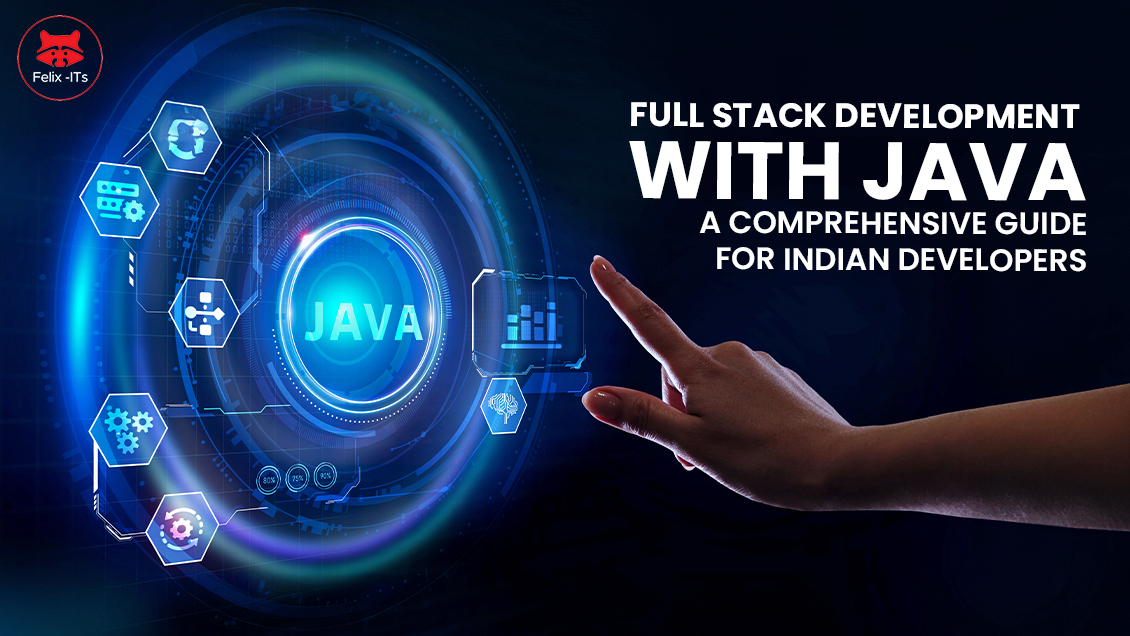The tech industry is rapidly evolving and so is the demand for versatile developers who can handle both front-end and back-end tasks. A simple answer to this demand is full-stack development. The professionals here are adept at creating and managing complete web applications. Out of all the other programming languages, Java is one of the best.
In this article, we will explore in detail full-stack development with Java. Including the benefits, career prospects, and how you can master this skill to become an invaluable asset in the tech industry, especially in the Indian context.
What is Full Stack Development?
Full stack development involves working on both the client-side (front-end) and server-side (back-end) of web applications. Full-stack developers are skilled in various technologies, frameworks, and languages, enabling them to build a complete, functioning application from scratch.
Front-End Development
Front-end development focuses on the user interface and user experience. It involves creating web pages and applications that users interact with directly. Technologies commonly used in front-end development include HTML, CSS, JavaScript, and frameworks like React, Angular, and Vue.js.
Back-End Development
Back-end development involves server-side logic, database management, and application integration. It ensures that the front end functions correctly and efficiently. Key technologies for back-end development include Java, Python, Ruby, Node.js, databases like MySQL, and MongoDB, and frameworks such as Spring and Hibernate.
Bonus Read – Frontend Developer: Everything You Need to Know
Why Choose Java for Full Stack Development?
Java has been a popular programming language for decades, known for its portability, scalability, and extensive ecosystem. Here’s why Java is a great choice for full-stack development:
Platform Independence
Java’s “write once, run anywhere” capability allows developers to create applications that can run on any device. Thanks to the Java Virtual Machine (JVM). This platform independence is crucial for building scalable and portable web applications.
Robust Ecosystem
Java offers a vast ecosystem with many libraries, frameworks, and tools. For full-stack development, Spring Boot and Hibernate simplify back-end work, while Maven and Gradle help with project management and build automation.
Strong Community Support
Java has a vast, active community of developers who contribute to forums, and open-source projects. Along with knowledge-sharing platforms that are beneficial to anyone who is learning Java. This community support ensures continuous learning and troubleshooting assistance for developers at all levels.
Security Features
Java’s robust security features—like bytecode verification, sandboxing, and cryptographic libraries—ensure secure web applications. This makes it a reliable choice for developers.
Key Components of Full Stack Java Development
To become proficient in full-stack development with Java, it’s essential to master the following components:
Core Java
A solid understanding of core Java concepts is a must. Such as object-oriented programming, data structures, algorithms, and exception handling is fundamental for any Java developer.
Front-End Technologies
Familiarity with front-end technologies is crucial for creating engaging user interfaces. Learn HTML, CSS, JavaScript, and frameworks like Angular or React to enhance your front-end skills.
Spring Framework
Spring is a powerful, feature-rich framework for building Java applications. Spring Boot, an extension of the Spring framework, simplifies the development of stand-alone, production-grade Spring-based applications.
Hibernate
Hibernate is an object-relational mapping (ORM) tool that simplifies database interactions. It allows developers to map Java objects to database tables, enabling seamless data manipulation and retrieval.
RESTful Web Services
Understanding how to create RESTful web services is vital for full-stack developers. These services allow different applications to communicate with each other over the web. It provides interoperability and integration capabilities.
Version Control Systems
Proficiency in version control systems like Git is essential for efficient collaboration and code management among developers. It allows for tracking changes, branching, and merging, ensuring smooth development processes and minimizing conflicts.
DevOps Practices
Familiarity with DevOps practices such as continuous integration and continuous deployment (CI/CD). This ensures smooth, automated deployment and testing processes, enhancing productivity and reducing errors.
Steps to Become a Full-Stack Java Developer
Learn Core Java
Start by mastering core Java concepts, focusing on object-oriented programming, data structures, and algorithms.
Master Front-End Technologies
Gain proficiency in front-end technologies like HTML, CSS, JavaScript, and popular frameworks like React or Angular.
Dive into Spring Framework
Learn the Spring framework and its modules, particularly Spring Boot, to simplify back-end development.
Understand Database Management
Familiarize yourself with SQL and NoSQL databases, and learn to use ORM tools like Hibernate for efficient data handling.
Build RESTful APIs
Practice creating RESTful web services to enable communication between different parts of your application.
Use Version Control Systems
Get comfortable with Git and GitHub for version control and collaborative development.
Adopt DevOps Practices
Learn the basics of DevOps, including CI/CD pipelines, to streamline your development and deployment processes.
Work on Real Projects
Apply your skills by working on real projects, contributing to open-source initiatives, or building your own applications.
Stay Updated
The tech industry is ever-evolving, so staying updated with the latest trends, tools, and technologies is crucial for continuous growth.
Career Prospects for Full Stack Java Developers in India
Full-stack Java developers are in high demand across various industries in India, including finance, healthcare, e-commerce, and technology. With businesses increasingly relying on web applications, the need for skilled developers who can manage both front-end and back-end tasks is growing. Here’s a list of industries requiring full-stack Java developers:
- Finance: Building secure, scalable banking applications.
- Healthcare: Developing health management systems and patient portals.
- E-commerce: Creating robust online shopping platforms.
- Technology: Innovating software solutions for various applications.
Job Roles and Salaries in India
Let’s take a look at some of the job roles and their salaries:
Full Stack Developer: Between ₹ 1.8 Lakhs to ₹ 16.0 Lakhs with an average annual salary of ₹ 9.1 Lakhs.
Java Developer: Between ₹ 2.0 Lakhs to ₹ 10.0 Lakhs with an average annual salary of ₹ 5.7 Lakhs.
Front-End Developer: Between ₹ 1.2 Lakhs to ₹ 12.0 Lakhs with an average annual salary of ₹ 6.0 Lakhs
Software Engineer: Between ₹ 2.8 Lakhs to ₹ 16.0 Lakhs with an average annual salary of ₹ 8.6 Lakhs.
Final Thoughts
Mastering full-stack development with Java opens up a world of opportunities in the tech industry. By combining your knowledge of front-end and back-end technologies, you can become a versatile developer capable of building comprehensive web applications. Whether you’re starting your journey or looking to enhance your skills, investing in full-stack Java development is a strategic move that can significantly boost your career prospects.
Are you ready to take the plunge into full-stack development with Java? Join our comprehensive training programs at Felix IT Systems, designed to equip you with the skills and knowledge needed to excel in this dynamic field.
With a decade of expertise in UI/UX design and full-stack development, we offer comprehensive courses tailored to industry needs. This ensures our students are equipped with the skills required to succeed in the competitive tech landscape.



